A Comparative Analysis of Friction and Energy Losses in Hydrogen and CNG Fueled Engines: Implications on the Top Compression Ring Design Using Steel, Cast Iron, and Silicon Nitride Materials
Abstract
:1. Introduction
2. Materials and Methods
2.1. Gas Blow-by Model
- A1, A2 and A3 are the cross-sectional areas of control volumes 1, 2 and 3;
- Pu, Pg, and Pl, are the gas pressures in control volumes 1, 2 and 3;
- Vu, Vg, and Vl, are the volumes in control volumes 1, 2 and 3;
- Tu, Tg, and Tl, are the gas temperatures in control volumes 1, 2 and 3;
- Pa, Va, and Ta, are the in-cylinder pressure, volume and temperature.
- Case 1—The first compression ring is assumed to be held firmly against the bottom groove lands within the piston groove, without fluttering, due to axial forces and pressure differentials. This position is maintained as the piston moves upward from BDC to TDC during the compression stroke (−180° ≤ φ < 0°).
- Case 2—The first compression ring is also assumed to remain almost pressed against the top groove lands inside the piston groove as the piston moves downward from TDC to BDC during the power stroke (0° ≤ φ < 180°). Dynamic phenomena such as piston ring flutter and collapse are disregarded;
- Combustion products are treated as ideal gases and follow the ideal gas law [40]. Namazian and Heywood [41] experimentally confirmed that the Reynolds number for gas mass flow in control volumes 1, 2, and 3 is relatively low (Re ≈ 10), validating the assumption of laminar flow for the gas blow-by problem. The combustion chamber to control volume 1 flow is considered fully laminar, resembling a Couette flow situation. Analyses of the crevice pressure drop have revealed it to be minimal, typically within 0.1–0.2% for standard production engine crevice sizes. Thus, we can assume that control volume 1’s pressure (Pu) remains uniform, matching the in-cylinder pressure (Pa) at every crankshaft rotation angle;
- The gas pressure behind the top ring (Pg) is assumed constant at each crank rotation angle. In control Volume 3, gas pressure (Pl) is uniform and set equal to crankcase pressure, considered equivalent to atmospheric pressure (patm) for every crank rotation angle;
- In Furuhama and Tada’s [42] study, gas temperatures in various control volumes were found to closely match the gas in-cylinder temperature. Consequently, for each crank rotation angle, we take Tu = Tg = Tl = Ta;
- Cross-sectional areas A1 and A3 are assumed to remain constant as the piston moves upward from BDC to TDC during the compression stroke (Case 1). The constant values of A1 and A3 change due to the piston’s reverse motion. Likewise, they are also assumed to remain constant as the piston moves downward from TDC to BDC during the power stroke (Case 2).
- l1 is the top land height and l3 is the second land height;
- tr is the piston groove radial length;
- cb is the back clearance between the piston and the ring;
- cs is the top clearance between the piston and the ring.
2.2. Quasi-Static Piston Ring Lubrication Model
2.3. Piston Ring Strength Analysis and Solution Methodology
3. Validation
4. Results and Discussion
4.1. Performance Characteristics of CNG and Hydrogen-Fueled Engines
4.2. Comparative Analysis of Ring Friction and Energy Losses
4.3. Effect of Hydrogen Delivery Method on Top Compression Ring Performance
5. Conclusions
- The gas blow-by predictions reveal the significant impact of engine parameters, notably piston geometry, on hydrogen- and CNG-fueled IC engines. The lighter hydrogen-fueled engine exhibited increased back gas pressure at the Top Dead Center (TDC) region due to its narrower ring gaps and higher in-cylinder pressure. In contrast, the heavier CNG IC engine demonstrated comparatively lower back gas pressures. Consequently, the hydrogen IC engine leads to higher viscous losses, resulting in a 34.7% increase in overall power losses compared to the CNG case. The similar idle speed, ignition system, and use of Port Fuel Injection (PFI) in both engines facilitate the extraction of in-cylinder pressure curves for prototype numerical investigations. Both in-cylinder pressure curves peak in the 70–80 bar range around Top Dead Center (TDC), validating their comparability;
- The analysis also highlights the importance of considering fuel delivery systems in frictional loss predictions using hydrogen. Particularly, the higher in-cylinder pressure using Direct Injection (DI) showed greater ring energy losses, by approximately 10.1%, compared to Port Fuel Injection (PFI). At the same time, regarding the choice of base ring material, the maximum Von Mises stress is 12.1% higher for the hydrogen fuel with the DI method compared to the hydrogen–PFI and CNG–PFI cases using the silicon nitride top ring, due to its superior strength compared to standard steel, stainless steel (AISI 201L), and cast iron (EN GJL 350).
Author Contributions
Funding
Institutional Review Board Statement
Informed Consent Statement
Data Availability Statement
Conflicts of Interest
Nomenclature
| A | apparent contact area | m2 |
| Ac | asperities contact area | m2 |
| A1, A2, A3 | cross-sectional areas of control volumes 1,2 and 3 | m2 |
| t | flat-faced ring radial thickness | m |
| b | ring face width | m |
| c | ring curvature | m |
| cb | back clearance between the piston and the ring | m |
| cs | top clearance between the piston and the ring | m |
| d | barrel-faced ring radial thickness | m |
| Eloss | energy loss | J |
| El | Young’s modulus of elasticity for liner | N/m2 |
| Er | Young’s modulus of elasticity for ring | N/m2 |
| E′ | equivalent modulus of elasticity | N/m2 |
| F5/2, F2 | statistical functions from GT approach | (-) |
| ftot | total friction | N |
| ffl | viscous friction | N |
| fb | boundary friction | N |
| FG | combustion gas force | N |
| Fel | ring tension force | N |
| g | ring free end gap | m |
| h | lubricant film thickness | m |
| hs | ring face profile | m |
| hmin | minimum film thickness | m |
| h1 | distance between the liner and the piston top land | m |
| h3 | distance between the liner and the piston second land | m |
| Ir | second moment of ring | m4 |
| l | connecting rod length | m |
| l1 | top land height | m |
| l3 | second land height | m |
| m | gas mass with regard to control volume | kg |
| gas mass flow rate | kg/s | |
| ng | dynamic viscosity of a binary gas mixture | Pa.s |
| Ptot | total power loss | W |
| Pa | in-cylinder gas pressure | N/m2 |
| Pl | pressure on the lower ring face | N/m2 |
| Pu | pressure on the upper ring face | N/m2 |
| Pg | gas pressure behind the piston ring | N/m2 |
| pel | elastic pressure | N/m2 |
| ph | hydrodynamic pressure | N/m2 |
| patm | atmospheric pressure | N/m2 |
| pc | combustion pressure | N/m2 |
| pin | inlet gas pressure | N/m2 |
| pout | outlet gas pressure | N/m2 |
| R | ideal gas constant | J⋅K−1⋅mol−1 |
| r | crank-pin radius | m |
| r0 | nominal cylinder radius | m |
| tr | piston groove radial length | m |
| Ta | in-cylinder gas temperature | K |
| Tav | average lubricant temperature | Κ |
| Tu | gas temperature above top compression ring | K |
| Tg | gas temperature behind the top compression ring | Κ |
| To | lubricant ambient temperature | Κ |
| Up | piston sliding velocity | m/s |
| Va | combustion chamber volume | m3 |
| Vg | volume behind the top compression ring | m3 |
| Vl | volume below piston ring and the second ring groove | m3 |
| Vu | volume above top compression ring | m3 |
| Wh | hydrodynamic load | Ν |
| Wc | asperities contact load | Ν |
| Greek symbols | ||
| δ | damping coefficient | (-) |
| ζκσrms | roughness parameter | (-) |
| κ | average asperity tip radius | (-) |
| λ | Stribeck oil film parameter | (-) |
| μ | lubricant dynamic viscosity | Pa.s |
| μasp | coefficient parameter of boundary shear strength | Pa.s |
| μο | lubricant dynamic viscosity at atmospheric pressure and ambient temperature | Pa.s |
| νr,νl | Poisson’s ratio of ring and liner | (-) |
| ρ | lubricant density | kg.m−3 |
| σr,σl | roughness parameter of ring and liner | μm |
| σrms | RMS roughness of examined tribo pair | μm |
| τ | viscous shear stress of the lubricant film | Pa |
| το | Eyring shear stress of the lubricant film | Pa |
| φ | crank rotation angle | Degrees |
| Φ | equivalence ratio (1/λeq) | (-) |
| ω | rotational engine speed | rpm |
Abbreviations
| BDC | Bottom Dead Center |
| CFD | Computational Fluid Dynamics |
| CNG | Compressed Natural Gas |
| DI | Direct Injection |
| FVM | Finite Volume Method |
| GT | Greenwood–Tripp |
| HICE | Hydrogen-fueled Internal Combustion Engines |
| IC | Internal Combustion |
| NEDC | New European Drive Cycle |
| PFI | Port Fuel Injection |
| RMS | Root Mean Square |
| SIMPLE | Semi-Implicit Method for Pressure Linked Equations |
| TDC | Top Dead Centre |
References
- Selleri, T.; Gioria, R.; Melas, A.D.; Giechaskiel, B.; Forloni, F.; Villafuerte, P.M.; Demuynck, J.; Bosteels, D.; Wilkes, T.; Simons, O.; et al. Measuring Emissions from a Demonstrator Heavy-Duty Diesel Vehicle under Real-World Conditions—Moving Forward to Euro VII. Catalysts 2022, 12, 184. [Google Scholar] [CrossRef]
- Reitz, R.D.; Ogawa, H.; Payri, R.; Fansler, T.; Kokjohn, S.; Moriyoshi, Y.; Agarwal, A.; Arcoumanis, D.; Assanis, D.; Bae, C.; et al. IJER editorial: The future of the internal combustion engine. Int. J. Engine Res. 2020, 21, 3–10. [Google Scholar] [CrossRef]
- Onorati, A.; Payri, R.; Vaglieco, B.; Agarwal, A.; Bae, C.; Bruneaux, G.; Canakci, M.; Gavaises, M.; Günthner, M.; Hasse, C.; et al. The role of hydrogen for future internal combustion engines. Int. J. Engine Res. 2022, 23, 529–540. [Google Scholar] [CrossRef]
- Hwang, J.; Maharjan, K.; Cho, H. A review of hydrogen utilization in power generation and transportation sectors: Achievements and future challenges. Int. J. Hydrogen Energy 2023, 48, 28629–28648. [Google Scholar] [CrossRef]
- Szamrej, G.; Karczewski, M. Exploring Hydrogen-Enriched Fuels and the Promise of HCNG in Industrial Dual-Fuel Engines. Energies 2024, 17, 1525. [Google Scholar] [CrossRef]
- Unich, A.; Bata, R.M.; Lyons, D.W. Natural Gas: A Promising Fuel for I.C. Engines; SAE International: Pittsburgh, PA, USA, 1993. [Google Scholar] [CrossRef]
- Mathai, R.; Malhotra, R.; Subramanian, K.; Das, L. Comparative evaluation of performance, emission, lubricant and deposit characteristics of spark ignition engine fueled with CNG and 18% hydrogen-CNG. Int. J. Hydrogen Energy 2012, 37, 6893–6900. [Google Scholar] [CrossRef]
- Das, L. Hydrogen-oxygen reaction mechanism and its implication to hydrogen engine combustion. Int. J. Hydrogen Energy 1996, 21, 703–715. [Google Scholar] [CrossRef]
- Zavos, A.; Nikolakopoulos, P.G. Investigation of the top compression ring power loss and energy consumption for different engine conditions. Tribol.-Mater. Surf. Interfaces 2022, 16, 130–142. [Google Scholar] [CrossRef]
- Richardson, D.E. Review of Power Cylinder Friction for Diesel Engines. J. Eng. Gas Turbines Power 2000, 122, 506–519. [Google Scholar] [CrossRef]
- Holmberg, K.; Andersson, P.; Erdemir, A. Global energy consumption due to friction in passenger cars. Tribol. Int. 2012, 47, 221–234. [Google Scholar] [CrossRef]
- Castleman, R.A. A Hydrodynamical Theory of Piston Ring Lubrication. Physics 1936, 7, 364–367. [Google Scholar] [CrossRef]
- Furuhama, S. A Dynamic Theory of Piston-Ring Lubrication: 1st Report, Calculation. Bull. JSME 1959, 2, 423–428. [Google Scholar] [CrossRef]
- Akalin, O.; Newaz, G.M. Piston Ring-Cylinder Bore Friction Modeling in Mixed Lubrication Regime: Part II—Correlation With Bench Test Data. J. Tribol. 2001, 123, 219–223. [Google Scholar] [CrossRef]
- Furuhama, S.; Sasaki, S. New Device for the Measurement of Piston Frictional Forces in Small Engines. AE Trans. 1983, 92, 781–792. [Google Scholar]
- Baelden, C.; Tian, T. A Dual Grid Curved Beam Finite Element Model of Piston Rings for Improved Contact Capabilities. SAE Int. J. Engines 2014, 7, 156–171. [Google Scholar] [CrossRef]
- Shahmohamadi, H.; Rahmani, R.; Rahnejat, H.; Garner, C.P.; King, P.D. Thermo-Mixed Hydrodynamics of Piston Compression Ring Conjunction. Tribol. Lett. 2013, 51, 323–340. [Google Scholar] [CrossRef]
- Zavos, A.; Nikolakopoulos, P.G. Computational fluid dynamics analysis of top compression ring in mixed lubrication. Mech. Ind. 2017, 18, 208. [Google Scholar] [CrossRef]
- Morris, N.; Rahmani, R.; Rahnejat, H.; King, P.D.; Fitzsimons, B. Tribology of piston compression ring conjunction under transient thermal mixed regime of lubrication. Tribol. Int. 2013, 59, 248–258. [Google Scholar] [CrossRef]
- Gore, M.; Morris, N.; Rahmani, R.; Rahnejat, H.; King, P.D.; Howell-Smith, S. A combined analytical-experimental investigation of friction in cylinder liner inserts under mixed and boundary regimes of lubrication. Lubr. Sci. 2017, 29, 293–316. [Google Scholar] [CrossRef]
- Zavos, A. Effect of Coating and Low Viscosity Oils on Piston Ring Friction under Mixed Regime of Lubrication through Analytical Modelling. Lubricants 2021, 9, 124. [Google Scholar] [CrossRef]
- Tung, S.C.; Gao, H. Tribological characteristics and surface interaction between piston ring coatings and a blend of energy-conserving oils and ethanol fuels. Wear 2003, 255, 1276–1285. [Google Scholar] [CrossRef]
- Zhuo, S.; Peijun, Z.; Leheng, Z.; Xinfu, X.; Aimin, H.; Wenquan, Z. Multi-layer compound coating on cast iron piston ring by multi-arc and magnetron sputtering ion compound plating technique. Surf. Coat. Technol. 2000, 131, 422–427. [Google Scholar] [CrossRef]
- Posmyk, A.; Bakowski, H. Wear Mechanism of Cast Iron Piston Ring/Aluminum Matrix Composite Cylinder Liner. Tribol. Trans. 2013, 56, 806–815. [Google Scholar] [CrossRef]
- Zabala, B.; Igartua, A.; Fernández, X.; Priestner, C.; Ofner, H.; Knaus, O.; Abramczuk, M.; Tribotte, P.; Girot, F.; Roman, E.; et al. Friction and wear of a piston ring/cylinder liner at the top dead centre: Experimental study and modelling. Tribol. Int. 2017, 106, 23–33. [Google Scholar] [CrossRef]
- Wróblewski, P. Technology for Obtaining Asymmetries of Stereometric Shapes of the Sealing Rings Sliding Surfaces for Selected Anti-Wear Coatings; SAE International: Pittsburgh, PA, USA, 2020. [Google Scholar] [CrossRef]
- Dziubak, T.; Dziubak, S.D. A Study on the Effect of Inlet Air Pollution on the Engine Component Wear and Operation. Energies 2022, 15, 1182. [Google Scholar] [CrossRef]
- Dolatabadi, N.; Forder, M.; Morris, N.; Rahmani, R.; Rahnejat, H.; Howell-Smith, S. Influence of advanced cylinder coatings on vehicular fuel economy and emissions in piston compression ring conjunction. Appl. Energy 2020, 259, 114129. [Google Scholar] [CrossRef]
- Mishra, P.C.; Roychoudhury, A.; Banerjee, A.; Saha, N.; Das, S.R.; Das, A. Coated Piston Ring Pack and Cylinder Liner Elastodynamics in Correlation to Piston Subsystem Elastohydrodynamic: Through FEA Modelling. Lubricants 2023, 11, 192. [Google Scholar] [CrossRef]
- Chen, T.; Wang, L.; Xu, J.; Gao, T.; Qin, X.; Yang, X.; Cong, Q.; Jin, J.; Liu, C. Effect of Groove Texture on Deformation and Sealing Performance of Engine Piston Ring. Machines 2022, 10, 1020. [Google Scholar] [CrossRef]
- Gomesantunes, J.M.; Mikalsen, R.; Roskilly, A.P. An investigation of hydrogen-fuelled HCCI engine performance and operation. Int. J. Hydrogen Energy 2008, 33, 5823–5828. [Google Scholar] [CrossRef]
- Balyts’kyi, O.I.; Abramek, K.F.; Mruzik, M.; Stoeck, T.; Osipowicz, T. Evaluation of the Losses of Hydrogen-Containing Gases in the Process of Wear of Pistons of an Internal-Combustion Engine. Mater. Sci. 2017, 53, 289–294. [Google Scholar] [CrossRef]
- Kindrachuk, M.; Volchenko, D.; Balitskii, A.; Abramek, K.F.; Volchenko, M.; Balitskii, O.; Skrypnyk, V.; Zhuravlev, D.; Yurchuk, A.; Kolesnikov, V. Wear Resistance of Spark Ignition Engine Piston Rings in Hydrogen-Containing Environments. Energies 2021, 14, 4801. [Google Scholar] [CrossRef]
- Rahmani, R.; Dolatabadi, N.; Rahnejat, H. Multiphysics performance assessment of hydrogen fuelled engines. Int. J. Engine Res. 2023, 24, 4169–4189. [Google Scholar] [CrossRef]
- Ferrarese, A.; Marques, G.; Tomanik, E.; Bruno, R.; Vatavuk, J. Piston Ring Tribological Challenges on the Next Generation of Flex-fuel Engines. SAE Int. J. Engines 2010, 3, 85–91. [Google Scholar] [CrossRef]
- ISO 6622-2:2013; Internal Combustion Engines—Piston Rings—Part 2: Rectangular Rings Made of Steel. International Organization for Standardization: Geneva, Switzerland, 2013.
- Baker, C.; Rahmani, R.; Karagiannis, I.; Theodossiades, S.; Rahnejat, H.; Frendt, A. Effect of Compression Ring Elastodynamics Behaviour upon Blowby and Power Loss. In SAE Technical Papers; SAE International: Pittsburgh, PA, USA, 2014. [Google Scholar] [CrossRef]
- Gulwadi, S.D. Analysis of Tribological Performance of a Piston Ring Pack. Tribol. Trans. 2000, 43, 151–162. [Google Scholar] [CrossRef]
- Ruddy, B.L.; Dowson, D.; Economou, P.N. A Theoretical Analysis of the Twin-Land Type of Oil-Control Piston Ring. J. Mech. Eng. Sci. 1981, 23, 51–62. [Google Scholar] [CrossRef]
- Turnbull, R.; Dolatabadi, N.; Rahmani, R.; Rahnejat, H. An assessment of gas power leakage and frictional losses from the top compression ring of internal combustion engines. Tribol. Int. 2020, 142, 105991. [Google Scholar] [CrossRef]
- Namazian, M.; Heywood, J.B. Flow in the Piston-Cylinder-Ring Crevices of a Spark-Ignition Engine: Effect on Hydrocarbon Emissions, Efficiency and Power; SAE International: Pittsburgh, PA, USA, 1982. [Google Scholar] [CrossRef]
- Furuhama, S.; Tada, T. On the Flow of Gas Through the Piston-Rings: 1st Report, The Discharge Coefficient and Temperature of Leakage Gas. Bull. JSME 1961, 4, 684–690. [Google Scholar] [CrossRef]
- Elkelawy, M.; Bastawissi, H.A.-E. Numerical Study on the Hydrogen Fueled SI Engine Combustion Optimization through a Combined Operation of DI and PFI Strategies. Energy Power Eng. 2013, 05, 513–522. [Google Scholar] [CrossRef]
- Ismail, A.; Nugroho, T. Experimental and Computational of Engine Cylinder Pressure Investigation on the Port Injection Dedicated CNG Engine Development. J. Appl. Sci. 2010, 10, 107–115. [Google Scholar] [CrossRef]
- Davidson, T.A. A Slmple and Accurate Method for Calculatlng Viscosity of Gaseous Mixtures I UNITED STATES DEPARTMENT OF THE INTERIOR I. Available online: https://www.osti.gov/biblio/6129940 (accessed on 11 September 2023).
- Speight, J.G. Combustion of hydrocarbons. In Handbook of Industrial Hydrocarbon Processes; Elsevier: Amsterdam, The Netherlands, 2020; pp. 421–463. [Google Scholar] [CrossRef]
- White, F.M. Viscous Fluid Flow, 2nd ed.; McGraw-Hill Series in Mechanical Engineering; McGraw-Hill: New York, NY, USA, 1991; Available online: https://cir.nii.ac.jp/crid/1130000796076615808.bib?lang=ja (accessed on 8 September 2023).
- Houpert, L. New Results of Traction Force Calculations in Elastohydrodynamic Contacts. J. Tribol. 1985, 107, 241–245. [Google Scholar] [CrossRef]
- Gohar, R.; Rahnejat, H. Fundamentals of Tribology; Imperial College Press: London, UK, 2008. [Google Scholar] [CrossRef]
- Greenwood, J.A.; Tripp, J.H. The Contact of Two Nominally Flat Rough Surfaces. Proc. Inst. Mech. Eng. 1970, 185, 625–633. [Google Scholar] [CrossRef]
- Teodorescu, M.; Kushwaha, M.; Rahnejat, H.; Rothberg, S.J. Multi-physics analysis of valve train systems: From system level to microscale interactions. Proc. Inst. Mech. Eng. Part K J. Multi-Body Dyn. 2007, 221, 349–361. [Google Scholar] [CrossRef]
- Zavos, A.; Nikolakopoulos, P.G. Tribology of new thin compression ring of fired engine under controlled conditions-A combined experimental and numerical study. Tribol. Int. 2018, 128, 214–230. [Google Scholar] [CrossRef]
- Baker, C.; Rahmani, R.; Theodossiades, S.; Rahnejat, H.; Fitzsimons, B. On the Effect of Transient In-Plane Dynamics of the Compression Ring Upon Its Tribological Performance. J. Eng. Gas Turbines Power 2015, 137, 032512. [Google Scholar] [CrossRef]
- Morris, N.; Mohammadpour, M.; Rahmani, R.; Rahnejat, H. Optimisation of the piston compression ring for improved energy efficiency of high performance race engines. Proc. Inst. Mech. Eng. Part D J. Automob. Eng. 2017, 231, 1806–1817. [Google Scholar] [CrossRef]
- Taylor, R.; Morgan, N.; Mainwaring, R.; Davenport, T. How much mixed/boundary friction is there in an engine—And where is it? Proc. Inst. Mech. Eng. Part J J. Eng. Tribol. 2020, 234, 1563–1579. [Google Scholar] [CrossRef]
- Koch, F.; Geiger, U.; Hermsen, F.-G. PIFFO—Piston Friction Force Measurements during Engine Operation; SAE International: Pittsburgh, PA, USA, 1996. [Google Scholar] [CrossRef]
- Stępień, Z. A Comprehensive Overview of Hydrogen-Fueled Internal Combustion Engines: Achievements and Future Challenges. Energies 2021, 14, 6504. [Google Scholar] [CrossRef]
- Yip, H.L.; Srna, A.; Yuen, A.C.Y.; Kook, S.; Taylor, R.A.; Yeoh, G.H.; Medwell, P.R.; Chan, Q.N. A Review of Hydrogen Direct Injection for Internal Combustion Engines: Towards Carbon-Free Combustion. Appl. Sci. 2019, 9, 4842. [Google Scholar] [CrossRef]
- Verhelst, S. Recent progress in the use of hydrogen as a fuel for internal combustion engines. Int. J. Hydrogen Energy 2014, 39, 1071–1085. [Google Scholar] [CrossRef]
- Ansys Granta, Ansys Granta Selector—Materials Selection Software, (2023 R2). Available online: https://www.ansys.com/products/materials/granta-selector (accessed on 17 November 2021).
- Dobrucali, E. The effects of the engine design and running parameters on the performance of a Otto–Miller Cycle engine. Energy 2016, 103, 119–126. [Google Scholar] [CrossRef]

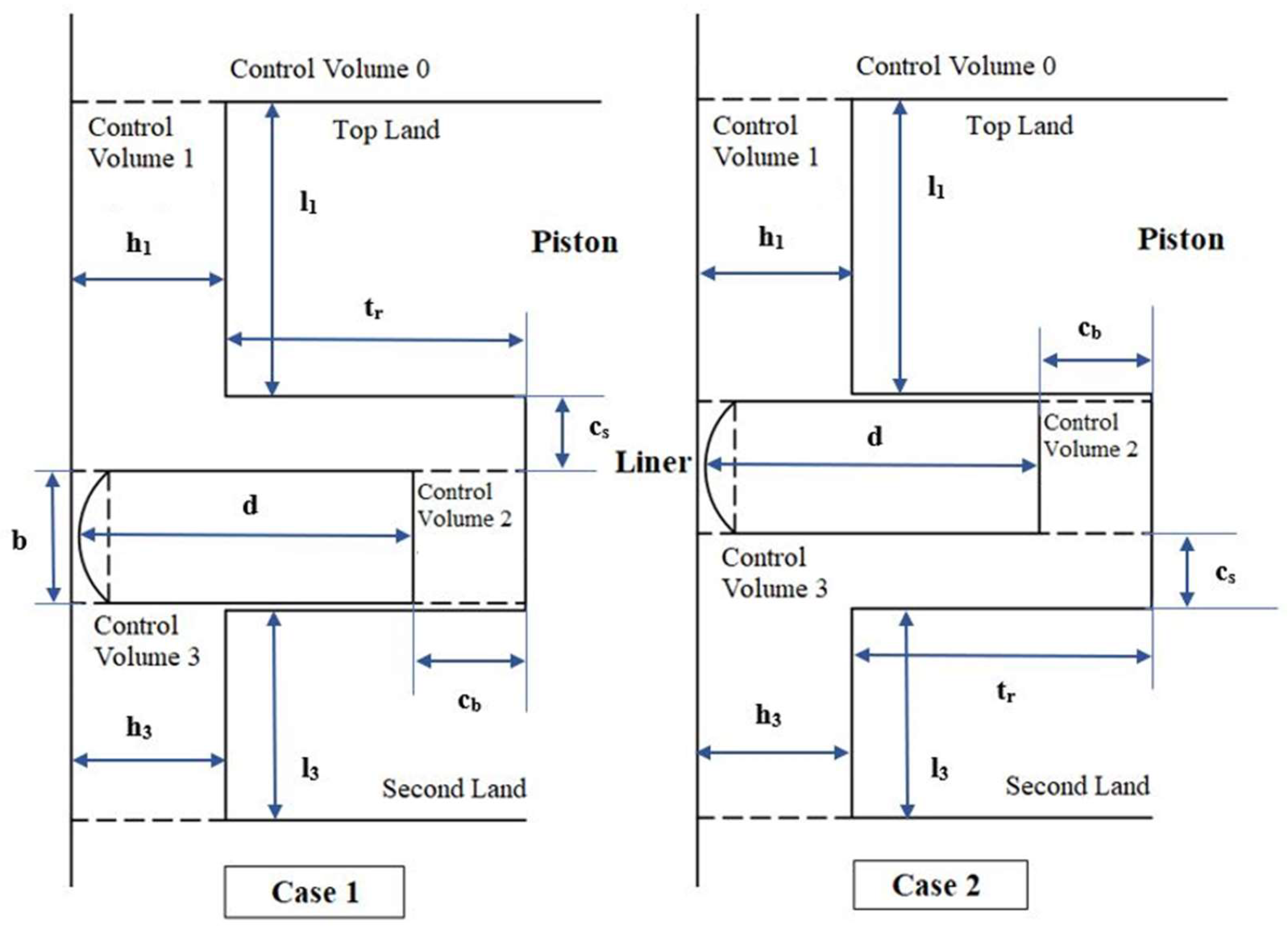

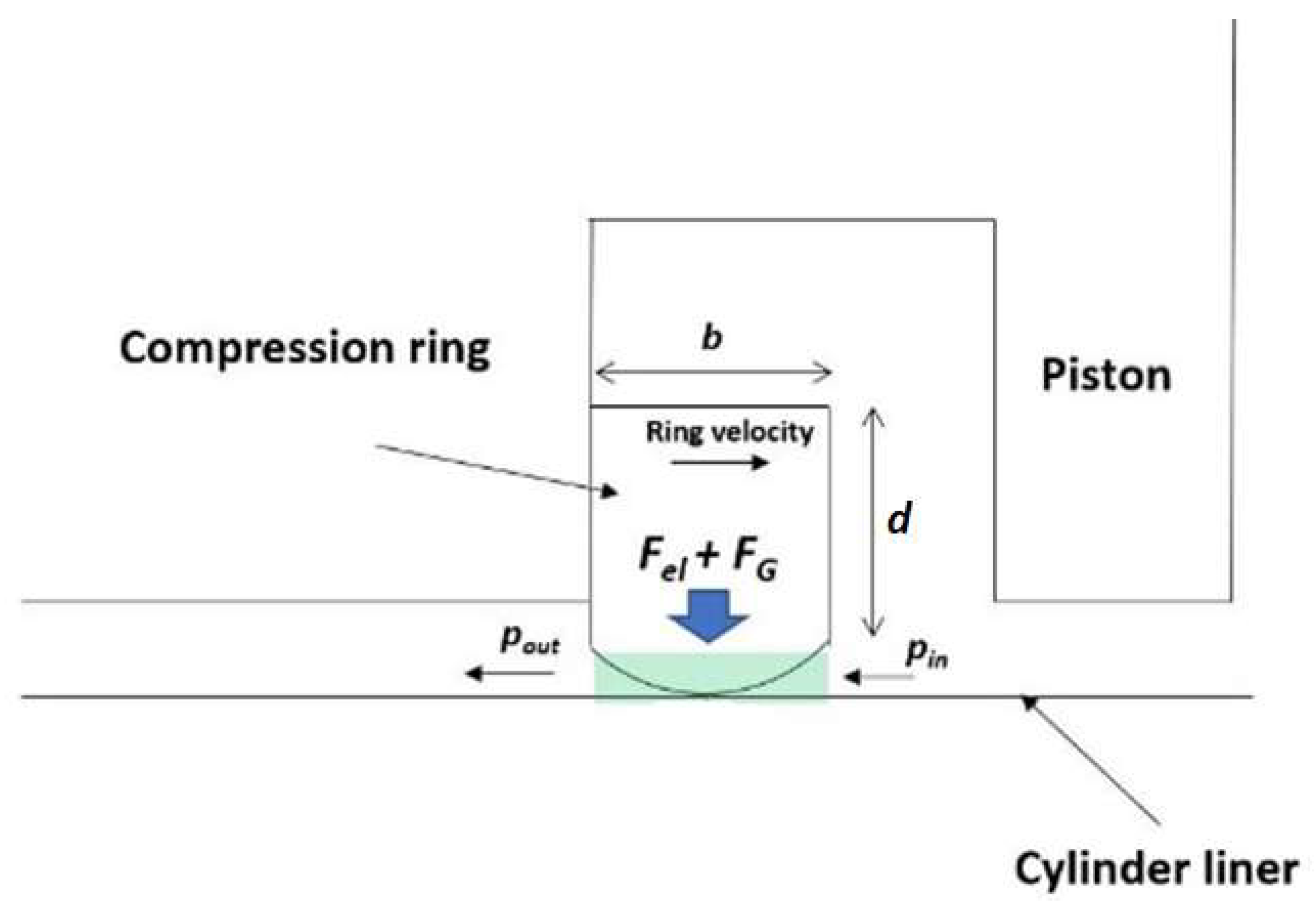
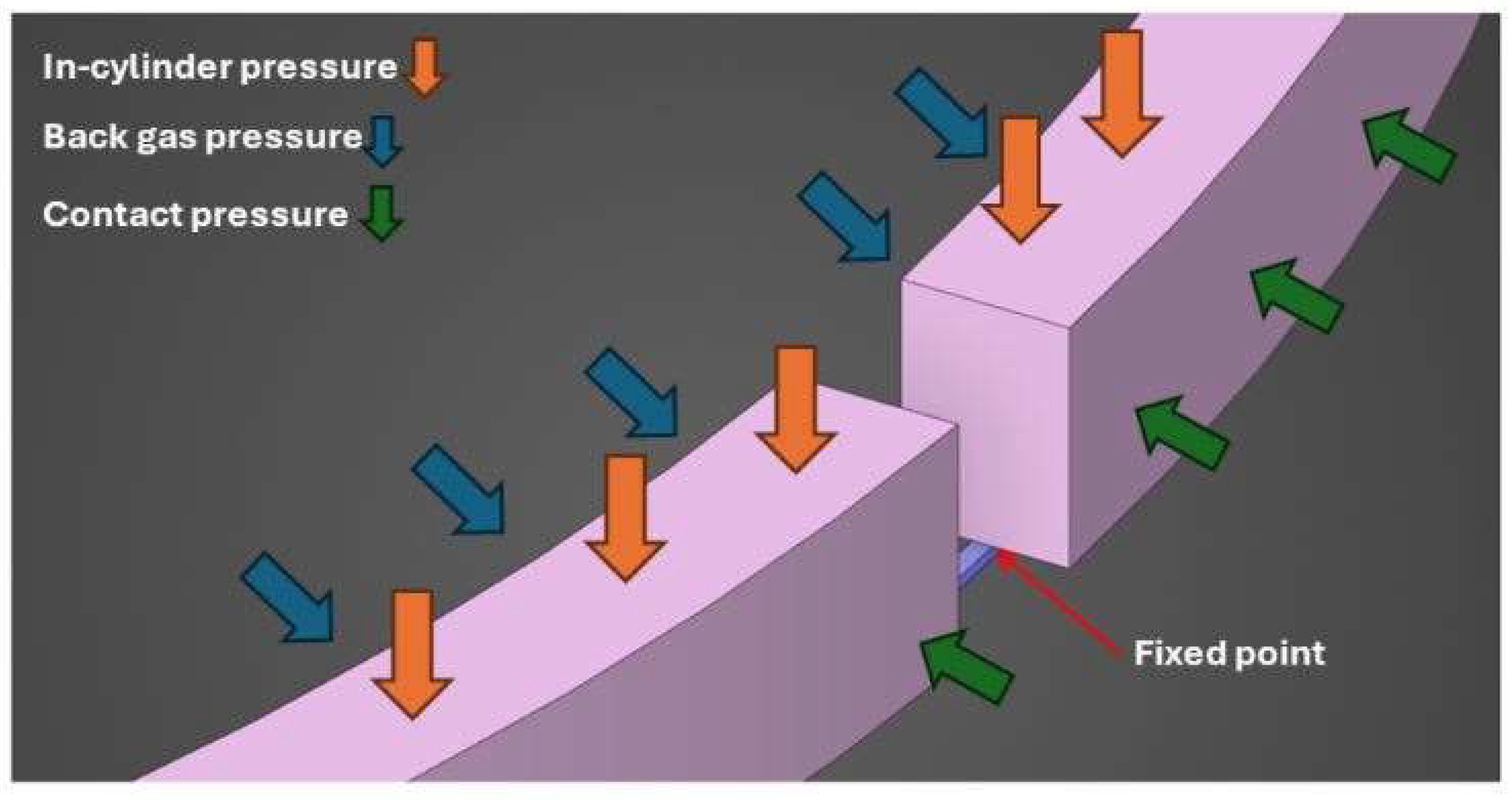
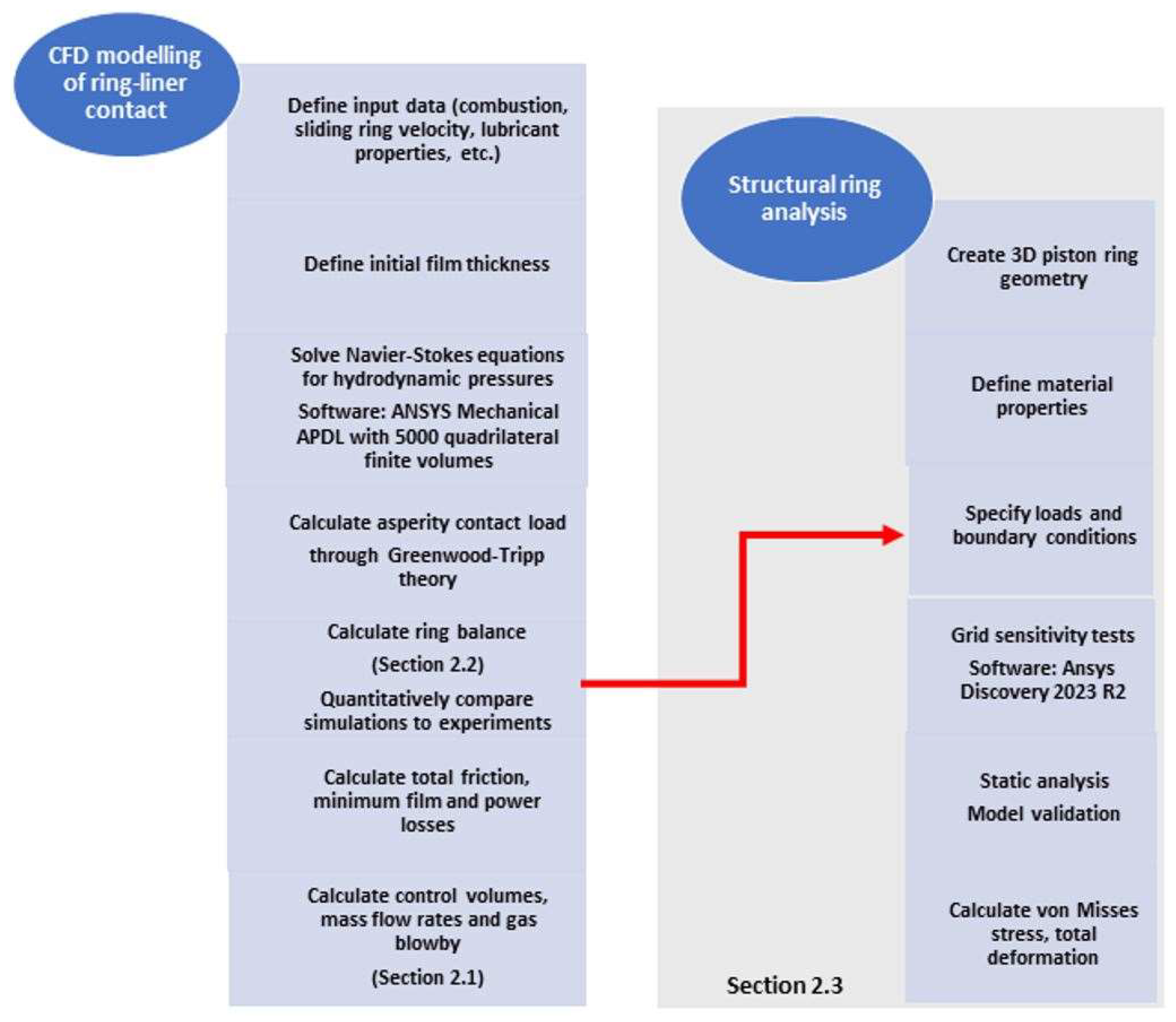
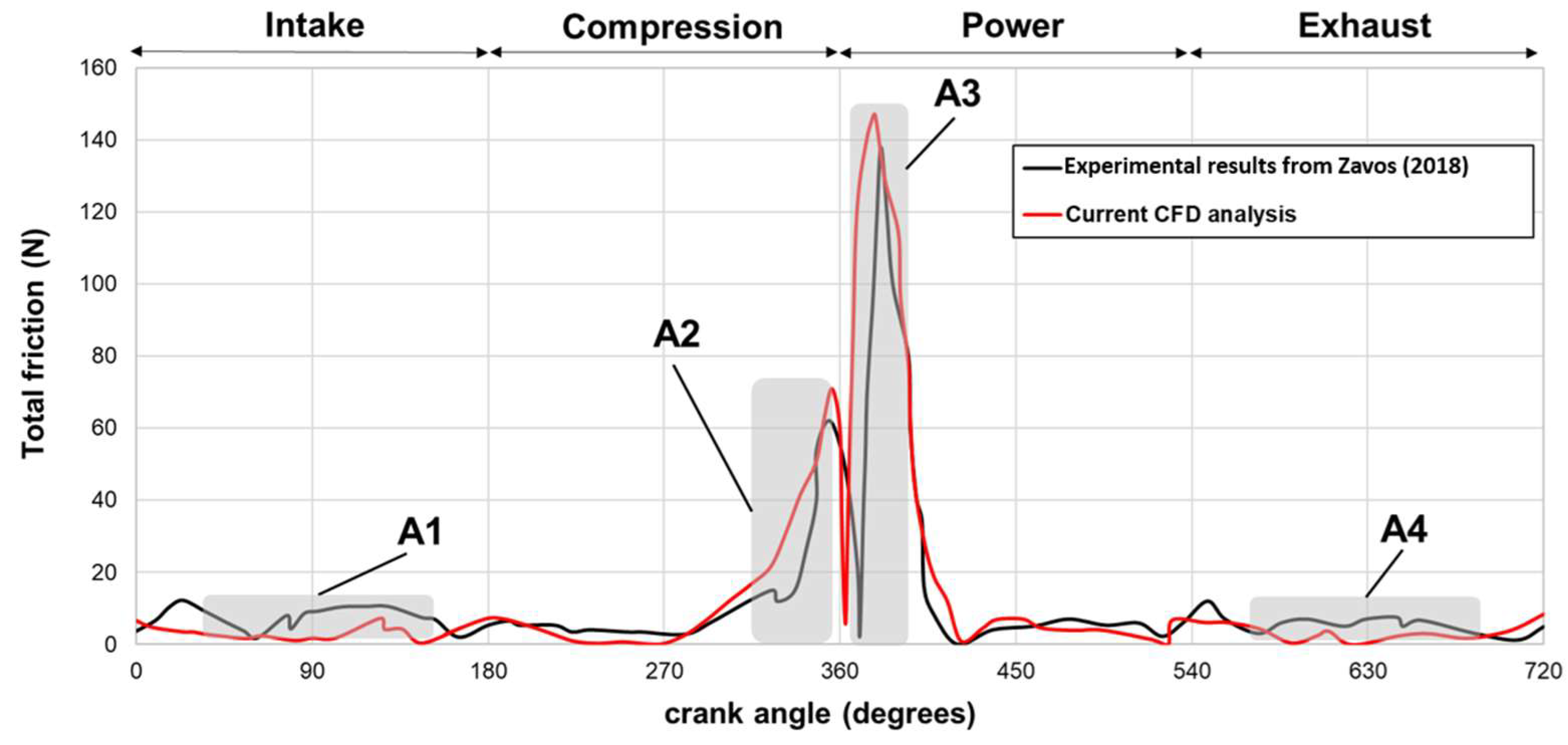
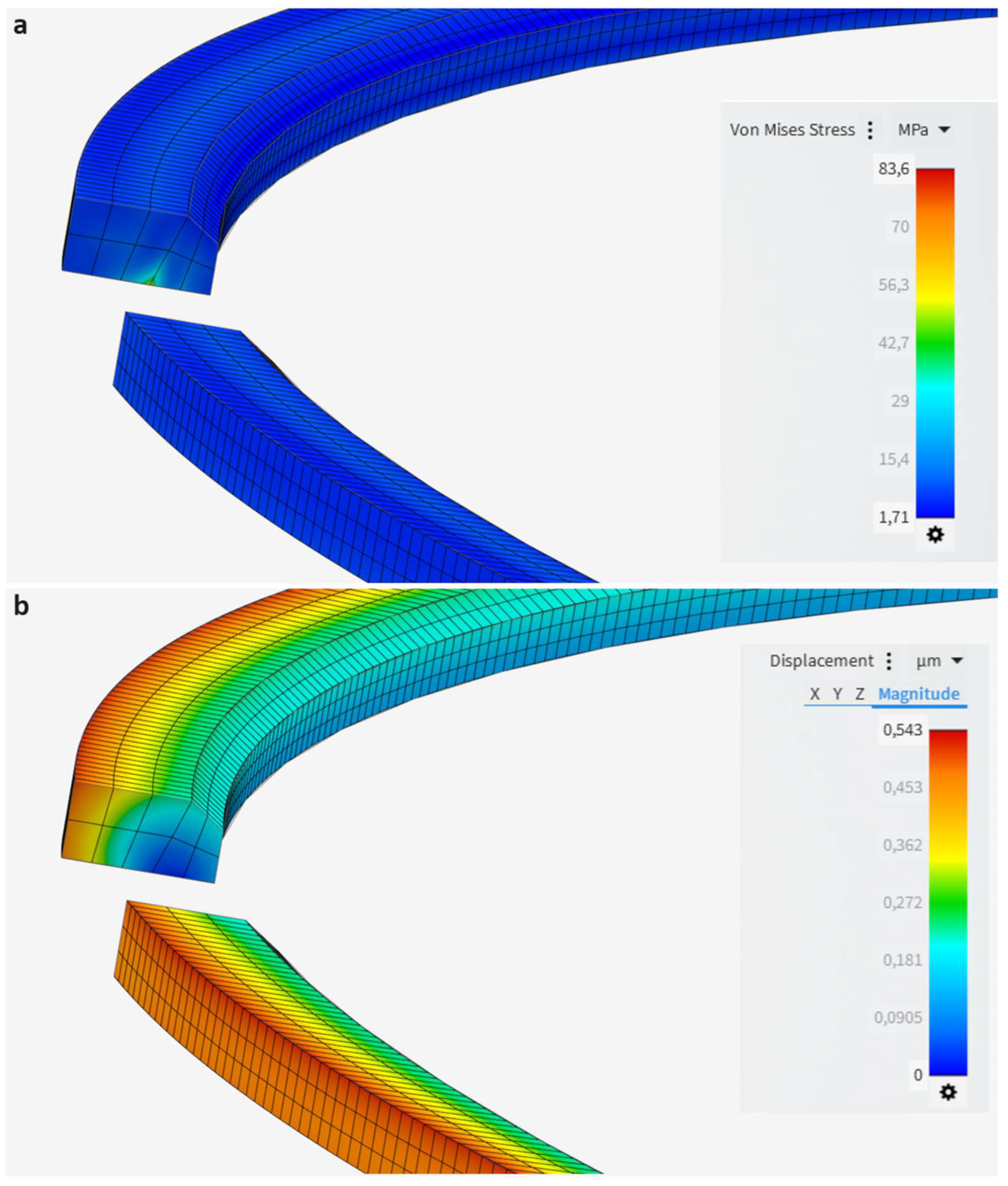
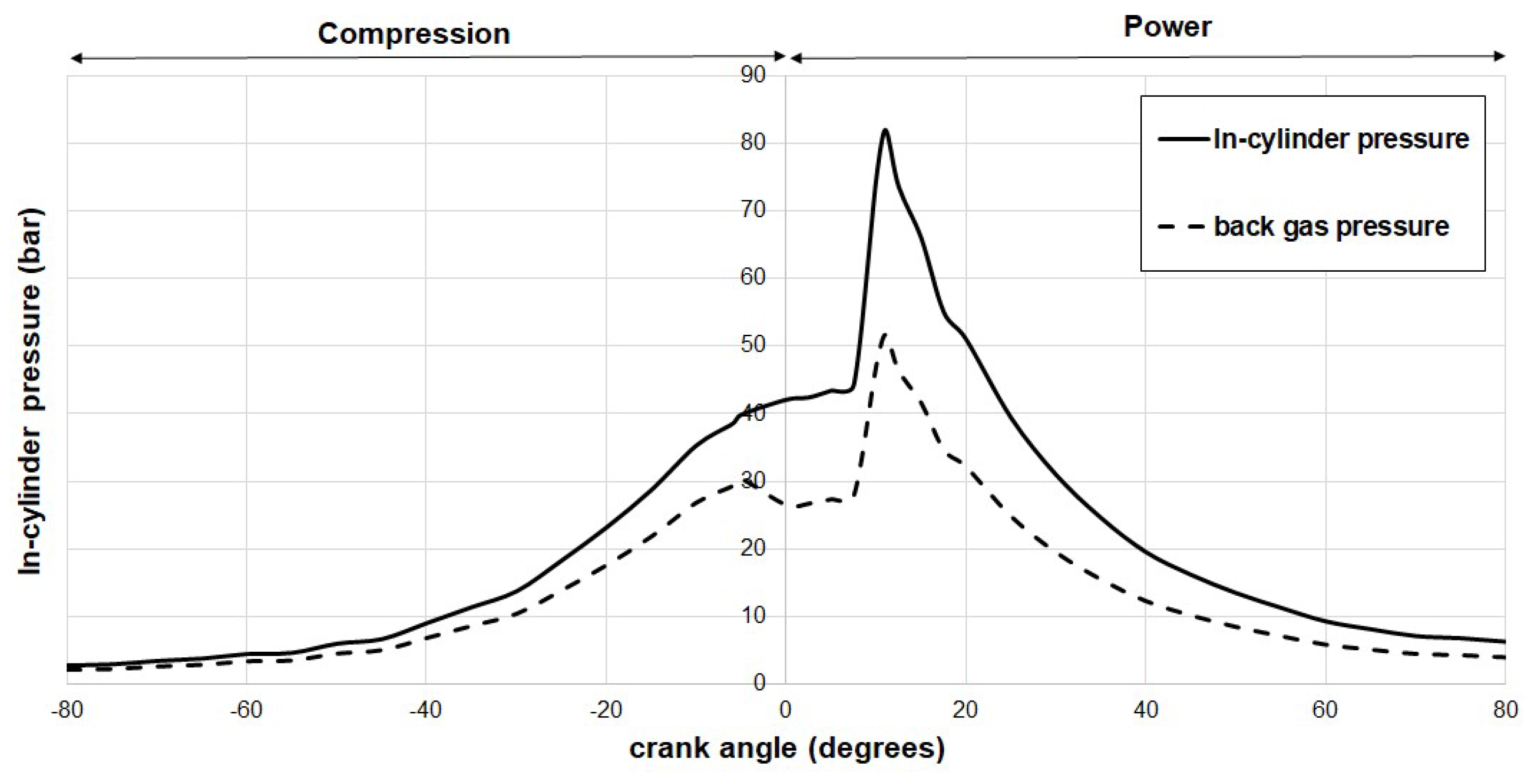

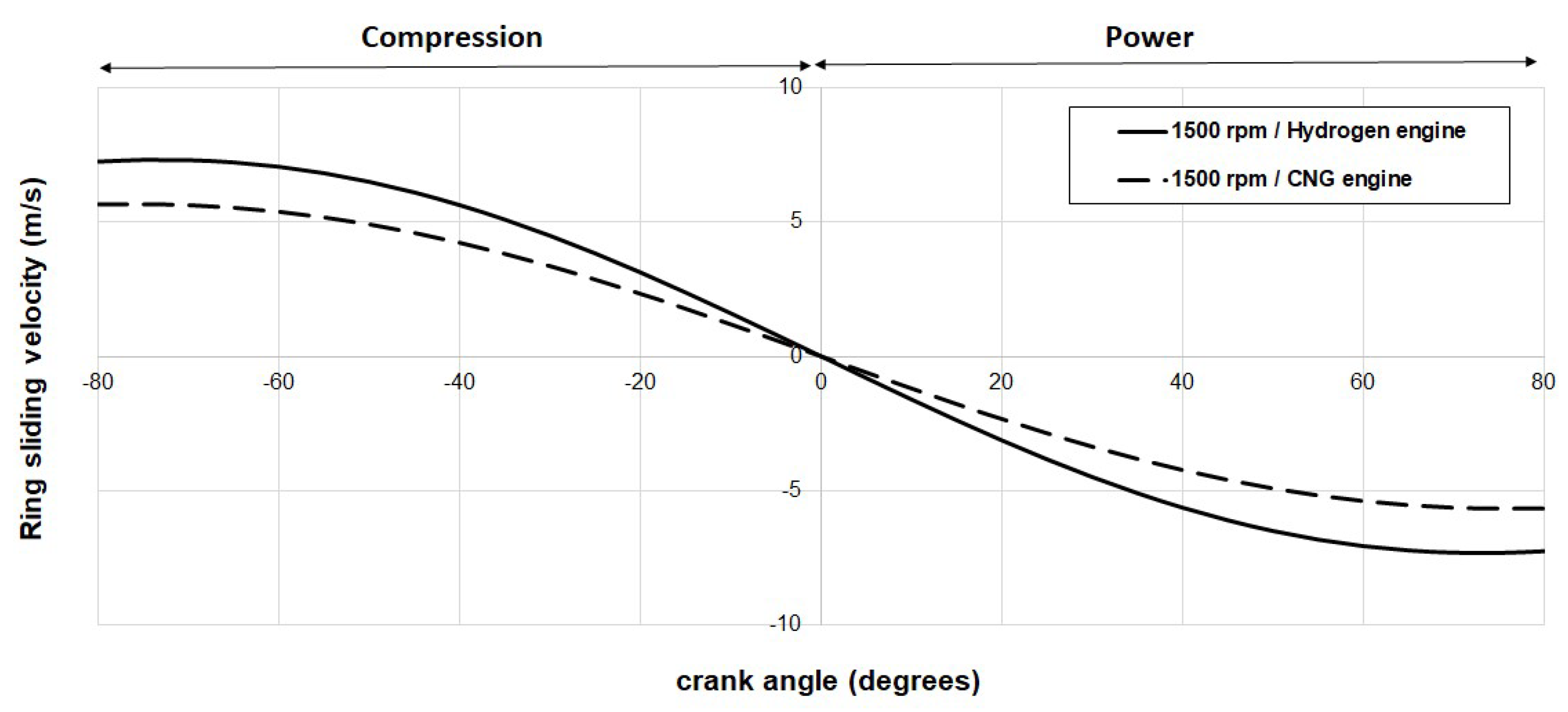
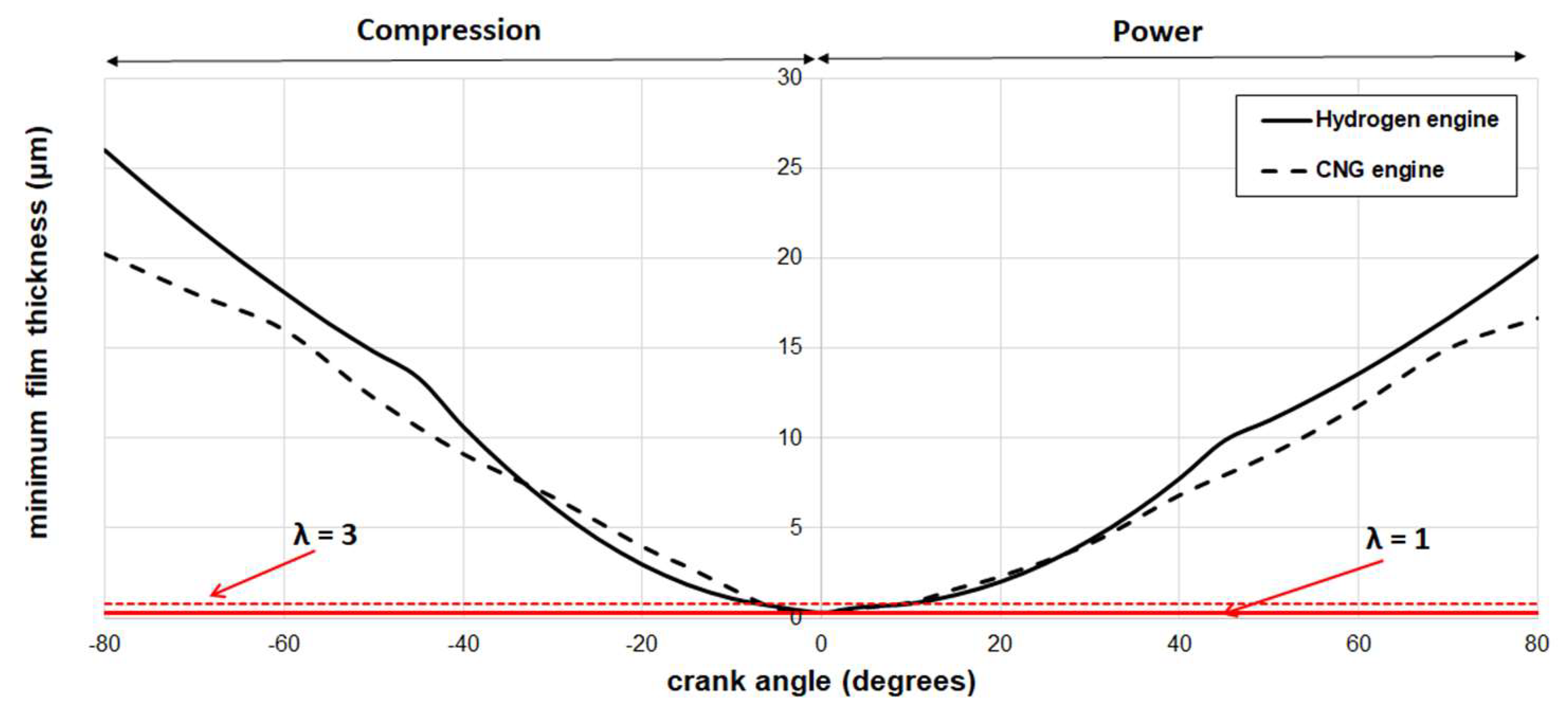
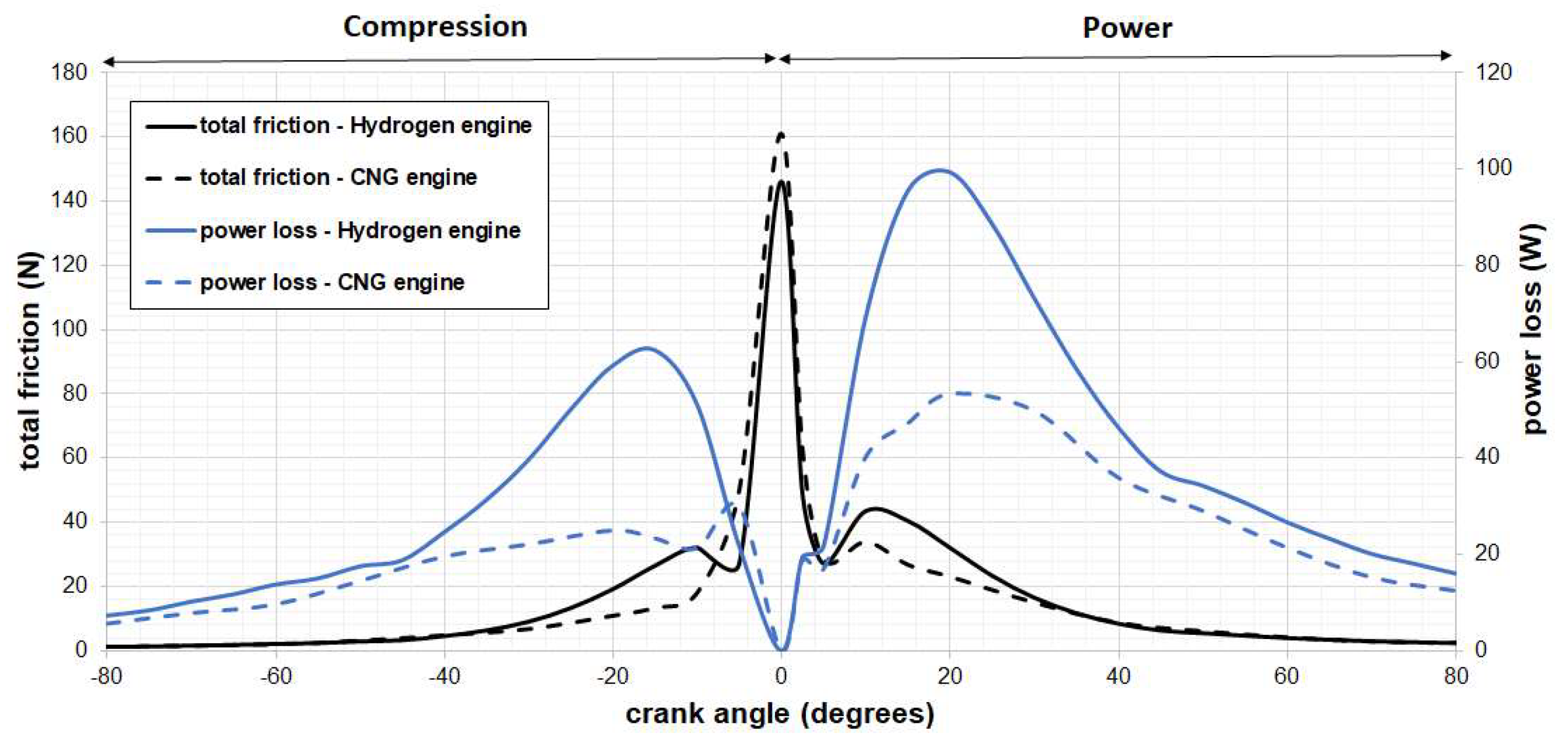
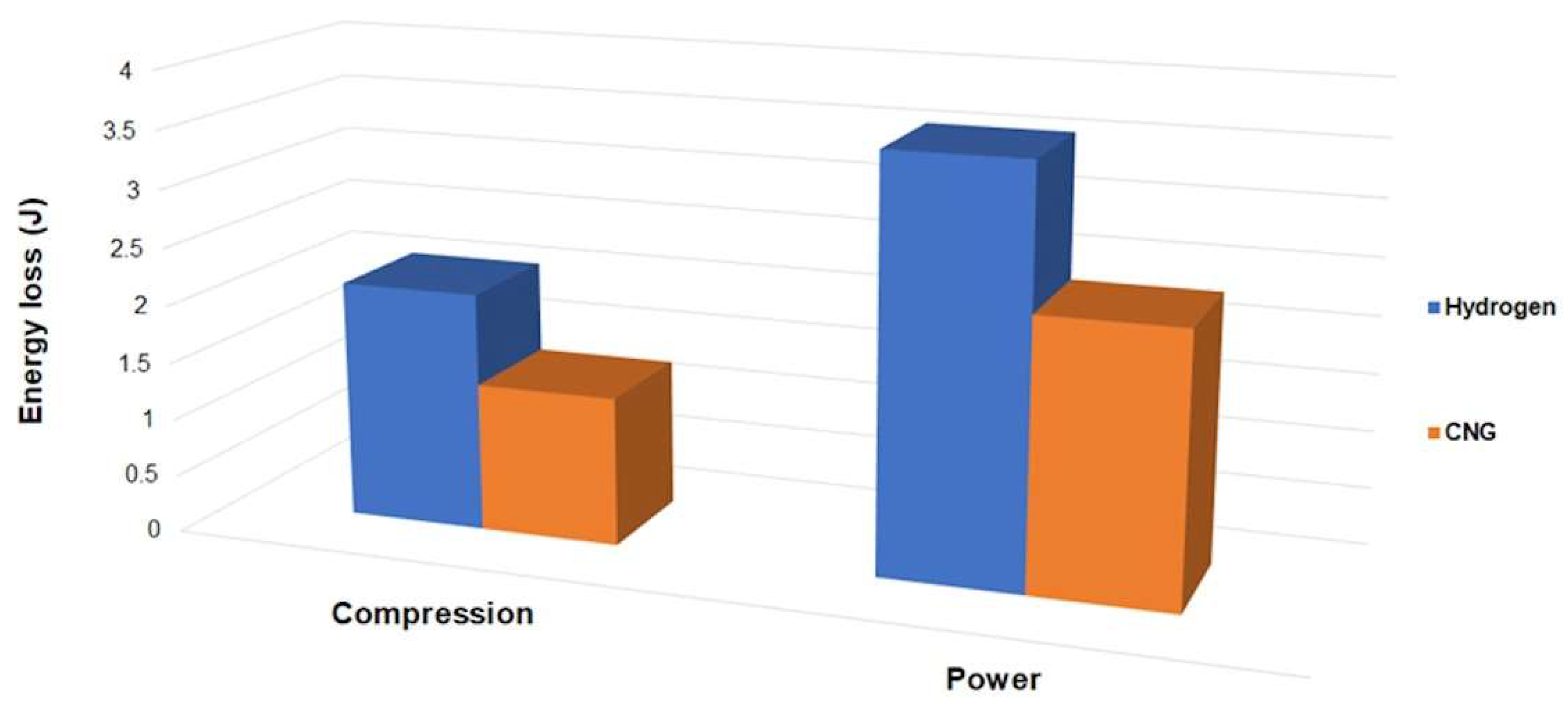

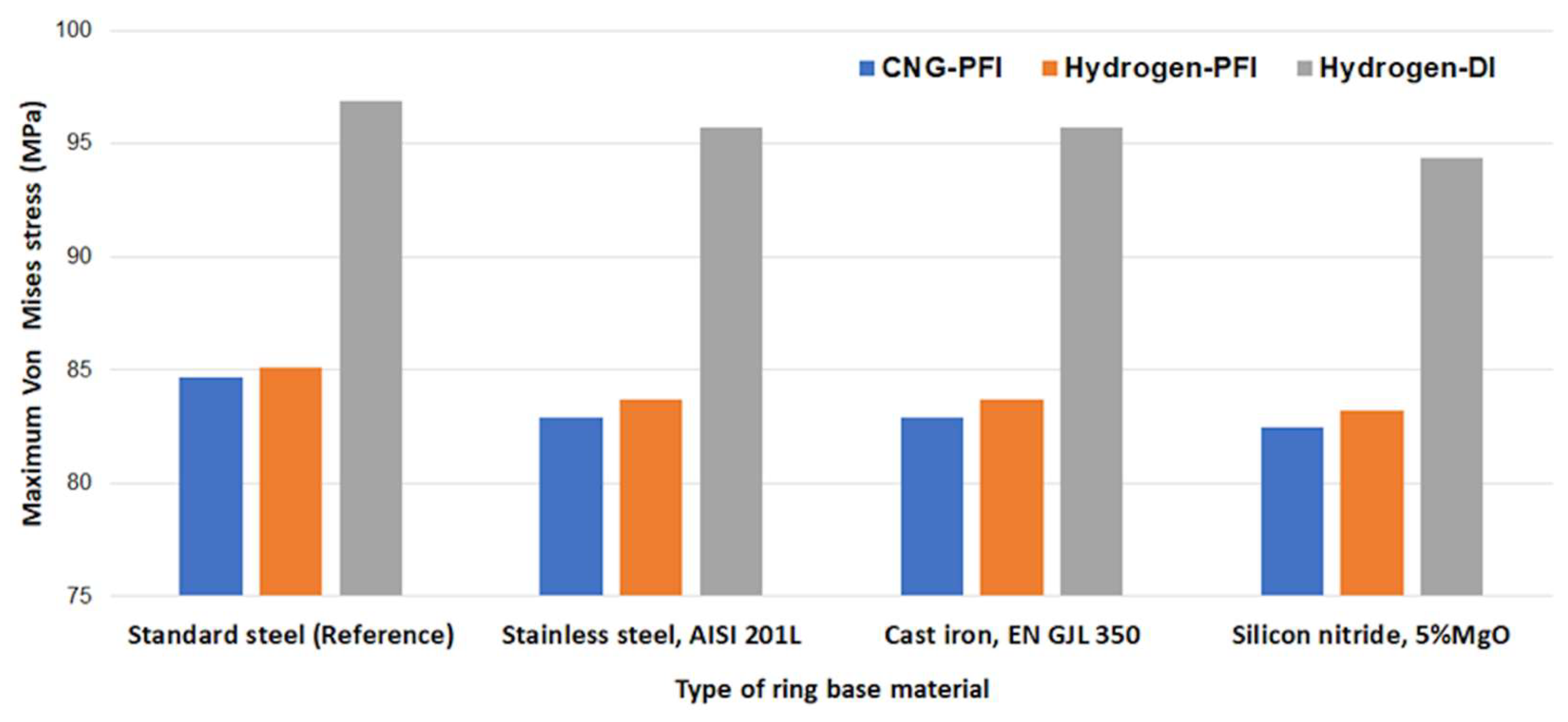
| Test | Element Size (mm) | Number of Elements | Von-Misses Stress (MPa) | Total Deformation (μm) |
|---|---|---|---|---|
| 1 | 1 | 1654 | 31.4 | 0.21 |
| 2 | 0.8 | 1984 | 34.5 | 0.218 |
| 3 | 0.6 | 4900 | 39.1 | 0.22 |
| 4 | 0.5 | 9508 | 83.2 | 0.23 |
| 5 | 0.4 | 13,972 | 82.7 | 0.25 |
| Parameter | Symbol | Value |
|---|---|---|
| Ring Young’s modulus of elasticity (GPa) | Er | 279 |
| Ring Poisson’s ratio | νl | 0.21 |
| Ring face width (mm) | b | 0.5 |
| Ring radial width (mm) | d | 2 |
| Ring end gap (mm) | g | 0.2 |
| Ring roughness (μm) | σr | 0.71 |
| Roughness parameter (-) | ζκσrms | 0.048 |
| Measure of asperity gradient (-) | σrms/κ | 0.116 |
| Liner Young’s modulus of elasticity (GPa) | El | 70 |
| Liner Poisson’s ratio | νl | 0.33 |
| Liner roughness (μm) | σl | 0.15 |
| Parameter | Hydrogen Engine | CNG Engine |
|---|---|---|
| Engine type | four stroke | four stroke |
| Volume displacement (cc) | 415 | 406 |
| Compression ratio | 14 | 14.5 |
| Bore (mm) | 76 | 86 |
| Stroke (mm) | 88 | 70 |
| Crank-pin radius (mm) | 44 | 35 |
| Connecting rod length (mm) | 131 | 138.1 |
| Idle speed (rpm) | 1500 | 1500 |
| Ignition system | Spark | Spark |
| Lubricant type | SAE10W40 | SAE10W40 |
| Lubricant density (kg.m−3) | 850 | 850 |
| Lubricant viscosity at the inlet (Pa.s) | 0.07 | 0.07 |
| Viscosity–temperature coefficient (K−1) | 4 × 10−2 | 4 × 10−2 |
| Viscosity–pressure coefficient (Pa−1) | 1 × 10−8 | 1 × 10−8 |
| Lubricant temperature (°C) | 40 | 40 |
| Parameter | Symbol | Value |
|---|---|---|
| Ring Young’s modulus (GPa) | Er | 209 |
| Ring Poisson’s ratio | νl | 0.3 |
| Ring face width (mm) | b | 2.5 |
| Ring radial width (mm) | d | 3.5 |
| Ring curvature (μm) | c | 9.55 |
| Ring end gap (mm) | g | 10 |
| Ring roughness (μm) | σr | 0.25 |
| Roughness parameter (-) | ζκσrms | 0.04 |
| Measure of asperity gradient (-) | σrms/κ | 0.0015 |
| Liner Young’s modulus (GPa) | El | 70 |
| Liner Poisson’s ratio | νl | 0.33 |
| Liner roughness (μm) | σl | 0.1 |
| Stroke | Hydrogen IC Engine | Pressure Drop | CNG IC Engine | Pressure Drop |
|---|---|---|---|---|
| Compression | Pa,min [bar] | 20% | Pa,min @ [bar] | 13% |
| 2.7 | 1.5 | |||
| Pg,min @ [bar] | Pg,min @ [bar] | |||
| 2.1 | 1.3 | |||
| Power | Pa,max @ [bar] | 37% | Pa,max @ [bar] | 37% |
| 81.9 | 68.8 | |||
| Pg,max @ [bar] | Pg,max @ [bar] | |||
| 51.5 | 43.3 | |||
| Pa,min [bar] | 36% | Pa,min @ [bar] | 35% | |
| 6.2 | 4.6 | |||
| Pg,min @ [bar] | Pg,min @ [bar] | |||
| 3.9 | 3 |
| Material | Standard Steel (Reference) | Stainless Steel, AISI 201L | Cast Iron, EN GJL 350 | Silicon Nitride, 5%MgO |
|---|---|---|---|---|
| Young’s modulus (GPa) | 209 | 197 | 94.5 | 310 |
| Poisson’s ratio (-) | 0.3 | 0.27 | 0.27 | 0.26 |
| Density (kg/m3) | 7850 | 7800 | 7300 | 3150 |
| Bulk modulus (GPa) | 166 | 142 | 70 | 219 |
| Shear modulus (GPa) | 76.9 | 77.5 | 37 | 122 |
| Tensile Yield Strength (MPa) | 250 | 310 | 124 | 644 |
| Tensile Ultimate Strength (MPa) | 460 | 788 | 188 | 644 |
Disclaimer/Publisher’s Note: The statements, opinions and data contained in all publications are solely those of the individual author(s) and contributor(s) and not of MDPI and/or the editor(s). MDPI and/or the editor(s) disclaim responsibility for any injury to people or property resulting from any ideas, methods, instructions or products referred to in the content. |
© 2024 by the authors. Licensee MDPI, Basel, Switzerland. This article is an open access article distributed under the terms and conditions of the Creative Commons Attribution (CC BY) license (https://creativecommons.org/licenses/by/4.0/).
Share and Cite
Nikolopoulou, V.-I.; Zavos, A.; Nikolakopoulos, P. A Comparative Analysis of Friction and Energy Losses in Hydrogen and CNG Fueled Engines: Implications on the Top Compression Ring Design Using Steel, Cast Iron, and Silicon Nitride Materials. Materials 2024, 17, 3806. https://doi.org/10.3390/ma17153806
Nikolopoulou V-I, Zavos A, Nikolakopoulos P. A Comparative Analysis of Friction and Energy Losses in Hydrogen and CNG Fueled Engines: Implications on the Top Compression Ring Design Using Steel, Cast Iron, and Silicon Nitride Materials. Materials. 2024; 17(15):3806. https://doi.org/10.3390/ma17153806
Chicago/Turabian StyleNikolopoulou, Vasiliki-Ioanna, Anastasios Zavos, and Pantelis Nikolakopoulos. 2024. "A Comparative Analysis of Friction and Energy Losses in Hydrogen and CNG Fueled Engines: Implications on the Top Compression Ring Design Using Steel, Cast Iron, and Silicon Nitride Materials" Materials 17, no. 15: 3806. https://doi.org/10.3390/ma17153806








